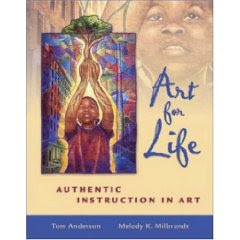- Watercolors are good for teaching color properties of hue, value, and intensity
- White watercolor or construction paper is recommended
- Use newspaper under paintings to speed up cleaning
- Round, pointed, soft-bristle, camel-hair brushed are recommended
- Watercolor boxes containing semimoist cakes should be cleaned at the end of the period, and left open to dry
- Change water containers when they become muddy
- Preliminary sketches are recommended
- Areas that are to appear white can be masked off during painting
- Students should begin with light colors and build to darker values
- Try combining with crayons or oil pastels in a resist method
- Art history examples: Winslow Homer, John Singer Sargent, and brush paintings from China and Japan
- Consider the importance of a vibrant, fresh appearance verses a labored, fussy, muddled appearance
PAINTING WITH TEMPERA
- Use discarded baby-food jars and half-pint milk cartons as containers
- For a class of 30, prepare about 60 containers of varying colors, 6 containers of white, and 4 containers of black
- Students can help out and gain color knowledge by helping prepare the paints
- Only fill the paint container to the length of the paint brush's bristles
- If possible, a separate brush should be available for each color of paint
- After use, squeeze excess paint into containers, then place brushes in a large basin of soapy water to soak overnight, then rinse in clear water
- Encourage students to make preliminary sketches in chalk or with a brush and light-colored paint
- Minimize clean-up by using newspapers
- Encourage students to wear protective clothing
- To keep paints from running together, avoid painting next to wet areas
- Tell students to squeeze out excess water thoroughly before using brush to paint again
- Consider using tempura resist methods with older students
MURAL MAKING
- Helps students acquire art knowledge and work with others to plan and carry out a project
- For a collage pin-up mural, urge students to make large and small figures and objects, use overlapping and object groupings, and use size to create sense of distance
- For scaling up a mural, use the grid method (1 foot = 5 feet is a convenient conversion)






No comments:
Post a Comment